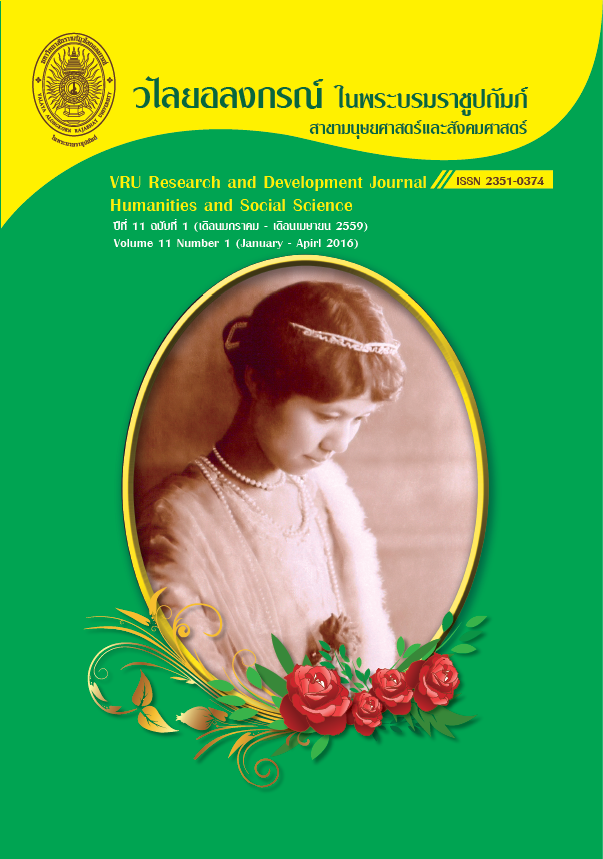การพัฒนากลยุทธ์การแข่งขันของธุรกิจรับซื้อของเก่า
Main Article Content
Abstract
งานวิจัยนี้มีวัตถุประสงค์เพื่อ 1) เพื่อวิเคราะห์สภาพแวดล้อมภายนอก และสภาพแวดล้อมภายในของธุรกิจรับซื้อของเก่า 2) เพื่อพัฒนากลยุทธ์การแข่งขันของธุรกิจรับซื้อของเก่า และ 3) เพื่อประเมินความเป็นไปได้ของกลยุทธ์การแข่งขันของธุรกิจรับซื้อของเก่าโดยใช้ผลการดำเนินงานขององค์กรเป็นเกณฑ์ กลุ่มตัวอย่างในการวิจัยครั้งนี้ มีจำนวนทั้งสิ้น 282 คน ได้แก่ 1) ประธานและกรรมการ บริษัท คัดแยกขยะเพื่อ รีไซเคิล วงษ์พาณิชย์ จำกัด จำนวน 5 คน และ 2) ผู้จัดการสาขา บริษัท คัดแยกขยะเพื่อรีไซเคิล วงษ์พาณิชย์ จำกัด จำนวน 277 คน กำหนดขนาดตัวอย่างโดยใช้ตารางสำเร็จรูปของ เครจซี่ และมอร์แกน และใช้การสุ่มตัวอย่างแบบแบ่งชั้นภูมิ เครื่องมือที่ใช้ในการวิจัยครั้งนี้ ได้แก่ แบบสัมภาษณ์ และแบบสอบถาม ซึ่งวิเคราะห์ข้อมูลโดยใช้เทคนิคการถดถอยพหุคูณแบบขั้นตอน
ผลการวิจัย พบว่า:
1) สภาพแวดล้อมภายนอกที่เป็นโอกาสในการดำเนินธุรกิจของบริษัทนั้น แยกได้เป็น 3 ด้าน คือ (1) โอกาสด้านสังคมและสิ่งแวดล้อม (2) โอกาสด้านยุทธศาสตร์ชาติ และ (3) โอกาสด้านความต้องการทางเศรษฐกิจ และสภาพแวดล้อมภายนอกที่เป็นอุปสรรคในการดำเนินธุรกิจของบริษัท แยกได้เป็น 2 ด้าน คือ (1) อุปสรรคด้านแรงงาน และ (2) อุปสรรคด้านการถดถอยทางด้านเศรษฐกิจ ในส่วนสภาพแวดล้อมภายในที่เป็นจุดแข็งในการดำเนินธุรกิจของบริษัท แยกได้เป็น 3 ด้าน คือ (1) จุดแข็งด้านความสามารถขององค์กร (2) จุดแข็งด้านชื่อเสียงและการบริการลูกค้า และ (3) จุดแข็งด้านความปลอดภัย และสภาพแวดล้อมภายในที่เป็นจุดอ่อนในการดำเนินธุรกิจของบริษัท แยกได้เป็น 2 ด้าน ได้แก่ (1) ประสิทธิภาพในการสรรหาพนักงานเข้าทำงาน และ (2) ความสามารถของพนักงานในร้าน
2) กลยุทธ์การแข่งขันที่ถูกพัฒนาขึ้นแยกได้เป็น 3 ด้าน ซึ่งประกอบด้วยกลยุทธ์ 9 กลยุทธ์ คือ (1) กลยุทธ์ SO ได้แก่ กลยุทธ์หนึ่งตำบลหนึ่งวงษ์พาณิชย์ กลยุทธ์การถ่ายทอดความรู้ กลยุทธ์การขยายธุรกิจไปข้างหน้า กลยุทธ์ร้านรับซื้อของเก่าสีเขียว กลยุทธ์วงษ์พาณิชย์เคลื่อนที่ กลยุทธ์เครือข่ายใยแมงมุม และ กลยุทธ์การตลาดเพื่อสังคม (2) กลยุทธ์ ST ได้แก่ กลยุทธ์การพัฒนาคนในสังคม และ (3) กลยุทธ์ WT ได้แก่ กลยุทธ์การพัฒนาทักษะความสามารถและคุณภาพชีวิตของพนักงาน
3) ในส่วนของผลการประเมินความเป็นไปได้ของกลยุทธ์การแข่งขัน พบว่า กลยุทธ์ที่มีอิทธิพลในทิศทางบวกต่อผลการดำเนินงานในภาพรวม และผลกำไรขององค์กรขององค์กร มากที่สุด ได้แก่ กลยุทธ์การพัฒนาทักษะความสามารถและคุณภาพชีวิตของพนักงาน นอกจากนี้ยังพบว่า กลยุทธ์ที่มีอิทธิพลในทิศทางบวกต่อคุณภาพของสินค้ามากที่สุด ได้แก่ กลยุทธ์ร้านรับซื้อของเก่าสีเขียว กลยุทธ์ที่มีอิทธิพลในทิศทางบวกต่อความรวดเร็วในการให้บริการลูกค้ามากที่สุด ได้แก่ กลยุทธ์การถ่ายทอดความรู้ กลยุทธ์ที่มีอิทธิพลในทิศทางบวกต่อความยืดหยุ่นปรับตัวตามสถานการณ์มากที่สุด ได้แก่ กลยุทธ์หนึ่งตำบลหนึ่งวงษ์พาณิชย์ และกลยุทธ์ที่มีอิทธิพลในทิศทางบวกต่อผลิตภาพขององค์กรมากที่สุด ได้แก่ กลยุทธ์การพัฒนาคนในสังคม
The purposes of this research were: 1) to analyze the internal and external environments of a recycling business, 2) to develop a competitive strategy, and 3) to evaluate the competitive strategy of the recycling business by using the firm’s performance as the indicator. The sample of this study were 282 persons comprised of 1) The president and 4 board members, and 2) 277 branch managers of the Wongpanit Recycling Company. The sample was obtained using the Krejcie and Morgan Formula and Stratified Random Sampling. The tools used for data collection were a questionnaire and in-depth interviews. The data analysis was based on Stepwise Multiple Regression.
The results of the study were as follows:
1. The aspects of external environments which held opportunities could be divided into three parts, namely: 1) society and environment 2) national strategy, and 3) economic needs. On the other hand, the aspects of external environments which held threats could be divided into two parts, namely: 1) labor, and 2) economic recession. The aspects of internal environments which were strengths could be divided into three parts, namely: 1) company’s capabilities 2) a good reputation for customer service, and 3) organizational safety. The internal environments which were weaknesses of the company could be divided into 2 parts, namely: 1) recruitment efficiency, and 2) employee capabilities.
2. Regarding competitive strategy development, there were three aspects of development containing nine strategies: 1) SO strategies namely: One District, One Recycling Company Strategy, Knowledge Transferring Strategy, Business Moving Forward Strategy, Green Recycling Business Strategy, Mobile Wongpanit Company Strategy, Spider Web Strategy, and Marketing for Society Strategy. 2) ST strategy namely: Human Development in the Community Strategy, and 3) WT strategy namely: Employees’ Skill and Quality of Life Development Strategy.
3. Regarding the evaluation of competitive strategy of the recycling business, The researcher found that the competitive strategy that had the most positive influence on total performance and profitability was the Employees’ Skill and Quality of Life Development Strategy. Additionally, the researcher found that the strategy that had the most positive influence on the quality of goods was the Green Recycling Strategy. The strategy that had the most positive influence on fast customer service was the Knowledge Transferring Strategy. The most positive influence on flexibility was the One District, One Recycling Company Strategy. Finally, Human Development in the Community was the strategy that had the most positive influence on company productivity.
Article Details
ลิขสิทธิ์บทความวิจัยที่ได้รับการตีพิมพ์เผยแพร่ในวารสารมนุษยศาสตร์และสังคมศาสตร์ วไลยอลงกรณ์ ในพระบรมราชูปถัมภ์ ถือเป็นกรรมสิทธิ์ของคณะมนุษยศาสตร์และสังคมศาสตร์ มหาวิทยาลัยราชภัฏวไลยอลงกรณ์ ในพระบรมราชูปถัมภ์ ห้ามนำข้อความทั้งหมดหรือบางส่วนไปพิมพ์ซ้ำ เว้นแต่จะได้รับอนุญาตจากมหาวิทยาลัยเป็นลายลักษณ์อักษร
ความรับผิดชอบ เนื้อหาต้นฉบับที่ปรากฏในวารสารมนุษยศาสตร์และสังคมศาสตร์ วไลยอลงกรณ์ ในพระบรมราชูปถัมภ์ เป็นความรับผิดชอบของผู้นิพนธ์บทความหรือผู้เขียนเอง ทั้งนี้ไม่รวมความผิดพลาดอันเกิดจากเทคนิคการพิมพ์
References
กระทรวงพาณิชย์ กรมพัฒนาธุรกิจการค้า. (2552). คู่มือธุรกิจบริการคัดแยกขยะเพื่อรีไซเคิล [ออนไลน์]. เข้าถึงข้อมูลวันที่ 22 มีนาคม 2554. จาก http://www.dbd.go.th/ mainsite/fileadmin/contents/information/brochure/09_Manual_Recycle.pdf.
คอตเลอร์ และ ลี. (2551). บรรษัทบริบาล (ความรับผิดชอบต่อสังคมขององค์กร) ทำการกุศลเพื่อภาพลักษณ์องค์กรและตอบสนองประเด็นสังคม. แปลจาก Corporate Social Responsibility Doing the Most Good For Your Company and Your Cause. โดย รมณียฉัตร แก้วกิริยา. กรุงเทพฯ: ยูนิเวอร์แซล พับลิซิ่ง.
ญาณัญฎา ศิรภัทร์ธาดา. (2553) ยุทธศาสตร์การสร้างมูลค่าเพิ่มของการคัดแยกขยะเพื่อรีไซเคิล เชิงธุรกิจสําหรับผู้ประกอบการและชุมชน ในเขตจังหวัดภาคกลางของประเทศไทย. รายงานการวิจัย คณะวิทยาการจัดการ มหาวิทยาลัยราชภัฏสวนสุนันทา.
ฟิลลิป คอตเลอร์. (2547). เจาะลึกการตลาด จาก A ถึง Z : 80 แนวคิดที่ผู้จัดการทุกคนต้องรู้ซึ้ง. พิมพ์ครั้งที่ 6. แปลจาก Marketing Insights from A to Z : 80 Concepts Every Manager Needs to Know. โดย ดนัย จันทร์เจ้าฉาย และ สมยอด คลังสมบัติ. กรุงเทพฯ: ดีเอ็มจี.
มารศรี เจษฎาปฏิพัทธ์ (2552). อิทธิพลของคุณสมบัติของทรัพยากร ความสามารถขององค์กร และความสามารถของผู้ประกอบการต่อผลการดำเนินงานขององค์การ: กรณีศึกษาธุรกิจรวบรวมและรับซื้อขยะรีไซเคิลในภาคตะวันออกของประเทศไทย. วิทยานิพนธ์หลักสูตรรัฐประศาสนศาสตรดุษฎีบัณฑิต คณะรัฐประศาสนศาสตร์ สถาบันบัณฑิตพัฒนบริหารศาสตร์.
สถาบันไทยพัฒน์. (2558). กลยุทธ์คู่สังคม [ออนไลน์]. เข้าถึงข้อมูลวันที่ 11 มีนาคม 2558. จาก https://thaicsr.sharefile.com/download.aspx?id=16b14be4867b4bdd
เสรีย์ นิ่มนงค์. (2553). โรงงานคัดแยกขยะเพื่อ รีไซเคิลวงษ์พาณิชย์ [ออนไลน์]. เข้าถึงข้อมูลวันที่ 2 พฤศจิกายน 2553. จาก http://www.ismed.or.th
Krejcie, R. V., & Morgan, D. W. (1970). Determinining Sample Size for Research Activities. [electronic version]. Educational and Psychological Measurement, 30, 607-610.
Martin, R. L. (2002, March). The Virtue Matrix: Calculating the Return on Corporate Responsibility - Shareholder Value Versus Corporate Responsibility [electronic version]. Harvard Business Review, 80, 1-11.
Porter, M. E. (1985). Competitive Advantage Creating and Sustaining Superior Performance: With A New Introduction. New York: Simon & Schuster In
Porter, M. E. & Kramer, M. R. (2002, December). The Competitive Advantage of Corporate Philanthropy [electronic version]. Harvard Business Review, 5-16.
(2006, December). Strategy and Society : The Link Between Competitive Advantage and Corporate Social Responsibility [electronic version]. Harvard Business Review, 1-15.
(2011, January-February). Creating Shared Value. [electronic version]. Harvard Business Review, 1-17.
Weihrich, H. (1982, April). The TOWS Matrix: A Tool for Situational Analysis [electronic version]. Long Range Planning, 15, 1-19.


